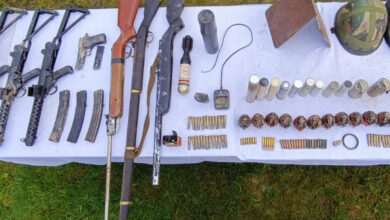India Boosts Military Arsenal In 2023: Acquires Cutting-Edge Platforms And Weapons

- Group Captain Shaliza Dhami was sent by the Indian Air Force to take charge of a frontline combat unit in the Western region.
- The Indian Army kept a close eye on the Line of Control and continued its actions against militants in Jammu and Kashmir in 2023.
India made plans to buy more than Rs 3.50 lakh crore worth of weapons in 2023. This was because of the ongoing border dispute with China in eastern Ladakh and other crises and conflicts around the world, which kept the military focused on ways to improve the country’s overall fighting skills so it could handle any security issues with confidence. India also stepped up its military cooperation with like-minded countries in its neighborhood and beyond. This was done because China was determined to become the dominant country in South Asia and become a regional hegemon.
The Indian forces that were guarding the nearly 3,500 km Line of Actual Control (LAC) stayed firm as the eastern Ladakh border grew into the fourth year. This happened even though both sides held several rounds of high-level military and diplomatic talks to try to solve the problem.
The fight between the world’s two largest armies mostly continued in the Demchok and Depsang regions, but both sides ended their involvement in a number of other trouble spots.
As more people became aware of the need to strengthen the country’s military, the defense ministry gave the go-ahead for a number of expensive purchases. These included buying 97 Tejas light combat aircraft, 156 Prachand combat helicopters, and improving 84 Su-30 fighter jets.
The Defense Acquisition Council (DAC) accepted plans worth more than Rs 3.50 lakh crore in 2023 to make the armed forces more ready for operations, the defense ministry said in a review of the year.
The DAC, which is the defense ministry’s top buying body, agreed in June to buy 31 MQ-9B long-endurance remotely piloted aircraft systems (RPAS) from the US through the foreign military sale (FMS) route. These will be sent to all three services.
In another important decision, the DAC agreed to let the Indian Navy buy 26 Rafale marine aircraft from the French defense company Dassault Aviation, along with weapons, a simulator, and spare parts. This was done as part of a deal between the two governments.
A few days after it was given to them in the city of Seville in southern Spain, the Indian Air Force officially took delivery of the first C-295 medium tactical transport aircraft.
Two years after India signed a Rs 21,935-crore deal with Airbus Defence and Space to buy 56 C295 passenger planes to replace its old Avro-748 fleet, the IAF got the first of the planes.
Airbus will deliver the first 16 planes ‘fly-away’ ready from its final assembly line in Seville by 2025. Tata Advanced Systems (TASL) will make and assemble the next 40 planes in India as part of an industrial partnership between the two companies.
During the year, the defense ministry also kept up its efforts to make India a center for making weapons for defense.
During Prime Minister Narendra Modi’s state visit to the US in June, American defense giant GE Aerospace signed a deal with Hindustan Aeronautics Limited (HAL) to work together on making F-414 fighter jet engines in India.
As part of the deal, India will co-produce GE Aerospace’s F414 engines, which will power the Tejas light combat aircraft Mk2.
The agreement was seen as a big step toward making the strategic relationship between India and the US even stronger.
Because military ties between the US and India are growing, two US Air Force B-1B Lancer fast heavy bomber jets joined the US booths at Aero India at the Yelahanka air base in February.
Officials in the US say that the bomber is the backbone of their long-range bomber force and can carry the most conventional guided and unguided bombs of any aircraft in the US Air Force.
In 2023, there was also a big improvement in India-France defense and military ties.
In July, the two countries announced a lot of innovative defense cooperation projects. For example, they will work together to make jet and chopper engines and build three Scorpene submarines for the Indian Navy.
The government also worked on its plan to increase defense production in the United States. In 2022–23, defense production reached a value greater than one lakh crore, which was a first.
PM Modi flew a mission in November in a Hindustan Aeronautics Limited-designed, developed, and built twin-seater Light Combat Fighter aircraft called “Tejas.”
Modi was shown what the Tejas could do during the 30-minute sortie. It was the first time an Indian prime minister made a sortie in a fighter plane.
In line with the government’s policy goals, the three services have done a lot of military drills with their counterparts from friendly countries over the last year to improve their ability to work together to solve problems.
At the tail end of the year, the Indian Navy started focused maritime security activities in the Arabian Sea because commercial ships were being attacked there.
The Liberian-flagged ship MV Chem Pluto, which had 21 Indian crew members, was attacked by a drone off the west coast of India on December 23. This caused security worries because it happened at the same time that Houthi militants backed by Iran attacked several commercial ships.
Another commercial crude oil ship, MV Sai Baba, which was on its way to India, was hit by what may have been a drone in the Southern Red Sea on the same day.
India also put a lot of effort into building up its border infrastructure in 2023. This year, defense minister Rajnath Singh presented 118 projects of the Border Roads Organization (BRO) to the country.
He began work on 90 infrastructure projects worth more than Rs 2,900 crore in September. These projects were spread out across 11 states and Union regions.
The defense budget was raised to Rs 5.94 lakh crore for 2023–24 in February. This is a small rise of 13% over last year’s allocation of Rs 5.25 lakh crore.
In many ways, women in the military broke through the glass ceiling that year as well.
In January, Captain Shiva Chauhan was the first woman officer to be sent to work at Kumar Post, Siachen Glacier. Siachen is the highest battlefield in the world.
Lt. Cdr. Prerna Deosthalee became the first woman officer to lead an Indian Naval warship, which was another important event.
Women are now being trained to become leaders in the Regiment of Artillery. In the year 2023, ten women were made officers in the Regiment of Artillery.
Group Captain Shaliza Dhami was sent by the Indian Air Force to take charge of a frontline combat unit in the Western region. She is the first woman in the IAF to lead a battle unit.
The Indian Army kept a close eye on the Line of Control and continued its actions against militants in Jammu and Kashmir in 2023.







Facebook Comments